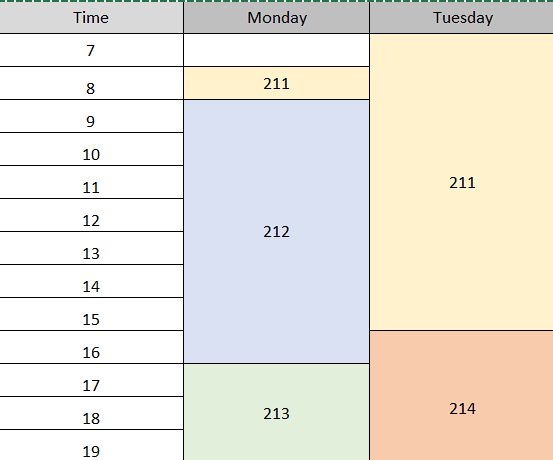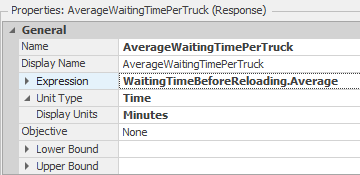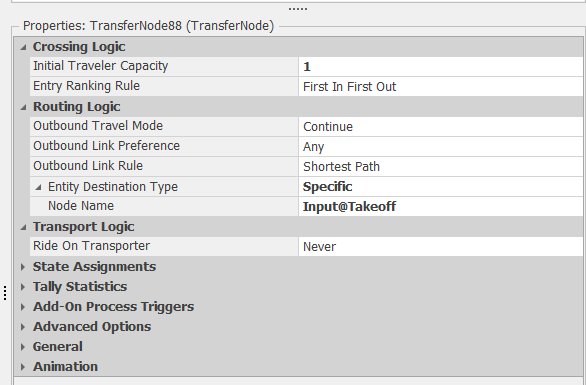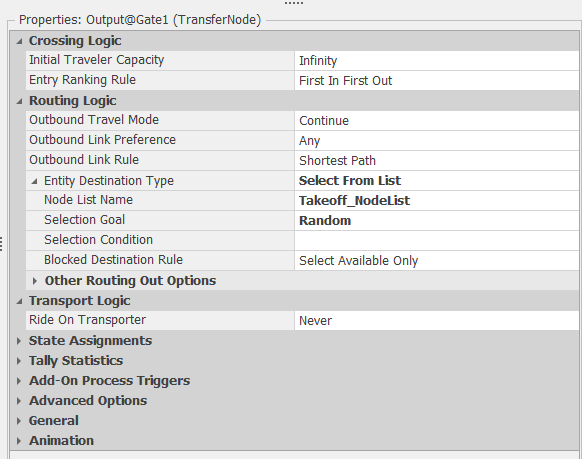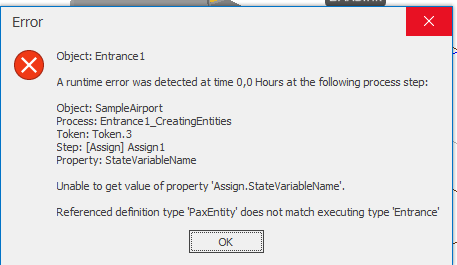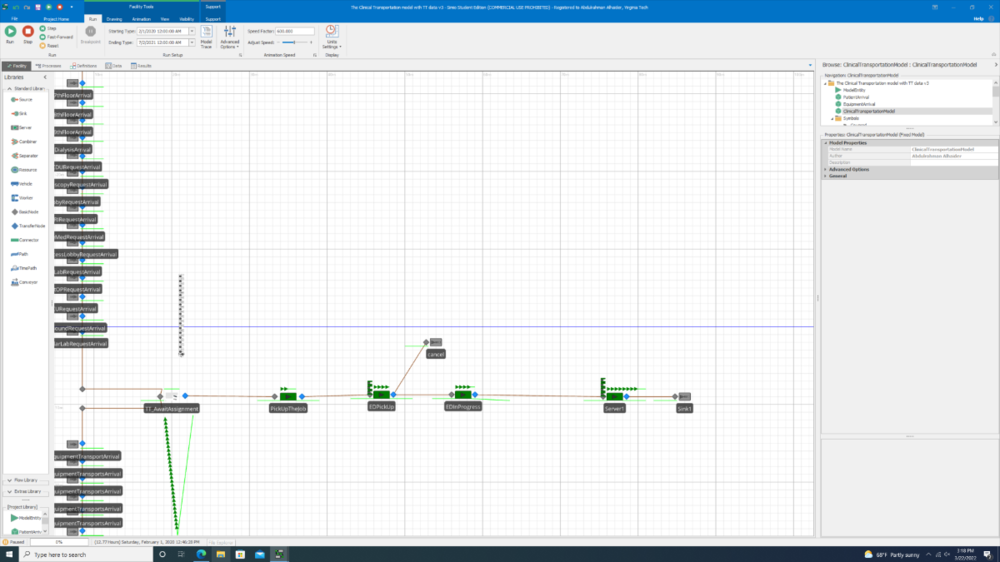Search the Community
Showing results for 'the maximum number in system limit for entities of type exceeded'.
-
Referenced definition type and executing type error
Gashi replied to Gashi's topic in SI General Discussions
Thank you for the quick answer! But i get the same error type when using MyModelEntity instead of MyVehicle. Referenced definition type "MyModelEntity" does not match executing type "MyVehicle". In the Transport Logic of the Output@Source1 (Properties), i have the MyVehicle as a transporter. It seems like both of them are executing the add on process trigger... -
Hi, I have 6 entities arriving at exactly 8am each day. Each of the 6 entities will create a certain number of entities on arrival from their respective distributions. How do I model in my source? I cannot have multiple sources as each entity has its own server processing times. Please can you help? Thank you
-
You can also use produce consume material method to add requirements to a process or processing step. You can see it when you change the process type to Task Sequence from Specific time. You can add more than one material requirement by adding tasks in parallel with same sequence number and specificying the material name and quantitiy that will be consumed for each parallel task. In that way you dont need to create and destroy uncessary entitites.
-
Hi, everyone I am developing a postgraduate project related to hospital OPD simulation. In one examination room, there will have a round 5 to 6 doctor using this room during the week. Now I am facing one problem, because every doctor process have difference processing time(function) as picture below(The number is doctor ID). Is there any method to set a difference process time during every shift in one server? or I have to create a process for this them?
-
Generating new entinty in combiner
Khaled Khamis replied to xdabroar's topic in SI General Discussions
Hi, A combiner is able to combine 1 or more entities into a parent entity. The number of entities that are batched together is specified in the property Batch Quantity. I recommend looking at the SimBit "Combine Multiple Entity Types Onto Pallets" for an example. Best, Khaled -
Hello everyone, I'm thrilled to share that I've successfully established my simulation model and conducted extensive verification and validation. Now, I'm ready to take the next exciting step: experimentation! While I've made considerable progress, I've encountered a minor setback. It seems that for certain scenarios, the response 'AverageWaitingTimePerTruck' isn't displaying any values. Interestingly enough, this issue only arises when conducting experiments with higher throughput values. The response is defined by averaging the tally statistic 'WaitingTimeBeforeReloading' of the Truck Entities in my model. Have any of you experienced a similar situation before? If so, I would greatly appreciate your insights on resolving this matter. Thank you in advance for your support! Best regards, Toon
-
Hi I have created an object and need now a property of type table for this object. The tables which can set for this property should have a defined schema (two columns, the first of type datetime and the second of type real). My question is: Is it possible to pretend the Definition of the Schema for the tables, which can be assigned to my property? Thanks for your help. Thomas
-
sorry for the trivial question: I have a system in which the source generates three different entities (A, B, C). I want you to generate a precise number of each one. For example, first 100 of type A, then 200 of type b and finally 300 of type c. So they do not have to be generated randomly. how can I do? Thanks in advance Carlo
-
I have a multiple combiners into which a single worker provides entities. While the worker is at a specific combiner, I want to check if that combiner's output buffer is full. I'd prefer not to create a separate process for each combiner as I have dozens. How do I code the process so that it is generic and that 1 process can work for any combiner? I'm hoping this is an easy question. Sorry if it's obvious. Thanks for your help.
-
Hi There, I have lots of experience in simulation but I'm new to Simio - my apologies if my Simio vocabulary/conceptualization is off or if this question has been asked already. I'm working to build a queue model simulation with a network of services and multiple staff types. In my mind, it makes the best sense to do this using the standard library of servers and resource pools (to visualize the network for stakeholders and be able to model multiple staff with different schedules that can each respond to multiple services). Right now, I am starting with a single stage M/M/c type queue to make sure that my implementation is correct before scaling this upwards. I checked out the SimBit titled 'Source – Server – Sink' that has three different M/M/c implementations; however, none of them use Resource Pool objects or combine process triggers with the standard library. I was able to implement a basic model that tries to combine a resource pool with a server by triggering separate Seize and Release process triggers on entry to the server object and after the processing time is completed, respectively. It runs without error; however, the results for average time in system (calculated by an average of a tally statistic that is only recorded for every 500th customer/entity), the results are one third less than in a scenario where I don't use a resource pool and set the capacity of the server explicitly, (which I validated against M/M/c formulae results). Does anyone have tips for how to link servers and resource pools and troubleshoot this scenario? Is there a SimBit or other example out there that is relevant? Am I triggering the seize/resource processes at the wrong points in time? Or is my framework for how to conceptualize this in the Simio environment missing a key concept? Thanks!!
-
Hello Everyone, please can someone help me with this situation? I want to use a Server as a storage place, entities coming out of it go into the MemberInput of a Combiner. I want the number of entities that leave the Server to depend on the state of the entity that will enter the ParentInput of the Combiner. How can I access the state of the parent entity that will enter the combiner from the Output Node of the Server? Thank you very much, Greetings! 14.10.spfx
-
FullGate version 17 (both side take off).spfx We encounter few problems: 1. Why the plane( entities) only go to one side for waiting to take off but not both side used? 2. Any fomular can i add into the simio? The plane will choose which path to go on the taxiway. Such as the plane on the Node 82 if the taxiway A(path 179) had 3 plane waiting but taxiway B (Path 160) had 1 plane waiting, than the plane will choose taxiway B to wait for take off. Gate.xlsx 30 Departure.xlsx
-
Hello River, I downloaded your files. The Gate512 was missing. I removed the information in the "30 Departure.xlxs" file that I can run the model ;-). Generally I understood how it works. Answer to your first question: I think you mean these two ways, right? From the left and from the right. In this case I saw that you used the "Routing Logic" in like all Transfernodes. The Outbound Link Rule is "Shortest Path" and you set the "Node Name" to "Input@Takeoff" Simio is using everytime the shortest link path now. Like in the screenshot below: In my opinion it would be better to set the destination once after the Entity got created in the Source for example :-). There are different ways to do that. In your model I removed all Routing Logic in the Transfernodes and used the Routing Logic only in the Output-TransferNodes of the Sources. In Simio you need only to use one time a SetNode-Step or a Routing-Logic to set the destination of an Entitiy and Simio will follow the paths or travel in the FreeSpace. You can use for example a NodeList with 2 different destinations and this Routing-Logic: With the "Selection Goal" Random Simio will randomly choose the destination from the NodeList. I uploaded you your model with the changes as an example: Problem on the taxiway version 17A.zip What did I changed? 1) I removed the Routing Logic in all TransferNodes. 2) I added new Routing Logic to the TransferNodes of the Output-Node of the Sources. 3) I added a NodeList with 2 new Nodes. 4) In the two new Nodes I used a Nodes-Entered-Process and a Transfer-Step to transfer the Entity to the Input of the Sink. Answer to your second question: You can change the destination of an Entity any time. In the Path (Link) you have a function called "NumberTravelors" for example to get the number of travelors currently on this path. So you can use a Expression like "Path123.NumberTravelors < 2". This can be used to decide if a way is full allready that the other way get selected. Or you can use a Integer-State and count up and down. I would use a Node-Entered-Process in the last possible node with a Decide-Step and two SetNode-Step in this case :-). I hope my answer will help you. When you have any other question, you are welcome! Best regards Pascal
-
I think if you set the max to 30, if 14 are generated all 14 (or other <30 number) will enter the workers ride queue and will be transported. You could also keep the ride capacity at 1, model the 14 pallets as 1 entity (lets call this a shipment entity), have the worker move that 1 entity to the next location, and then use a separator to turn the shipment entity into some number of pallet entities. Attached is an example. example 9.23.22.spfx
-
Hi, I am trying to use an assign step to assign a date/time state from a table to an entity. When I try to run the model, I get the following error: "Referenced definition type 'PaxEntity' does not match Executing type 'Entrance'. Entrance in this case is a source object. What is this executing type it is talking about? Any ideas on how to fix this are also appreciated. Kind regards, Jason Airport Library.spfx
-
Hi, I have an issue related to workers going off-shift and abandoning the reserved entities in different servers, depending on when the shift change happens (picture attached is an example). The shift change is based on switching from Worker of x number of population to y number of population to meet my WorkSchedule. The Worker should always carry different entities throughout, entities cannot travel alone. The logic issue happens as a result of entities left in servers or buffers that were not picked up by workers due to the end of shifts, causing too many objects/entities in the system not destroyed. An expert suggested to build process that checks the Worker's Allocation Queue when it goes off shift to see if there are any entities in it, and if there are, turn the Worker back on shift. I tried to build that process, but I could find the right steps. Any help on identifying the right steps or a different way to model workers shifts is appreciated.
-
Hi I want my simulation to start with some entities at the output node of a server. Is that possible? Thanks in advance Janus
-
We are building a model of a medical facility where some patients need to be evacuated out of the model using a vehicle. In its current state, when a patient is in the ward or ICU, it will be determined if they need to evacuate. While they are waiting for an evacuation transport, they will be in a task sequence loop. We would like some way for the patient to seize a spot on the transport, perform the tasks loops, and once the transport arrives at the facility transfer node, the patients break out of their loop, and seize a worker to be carried to the vehicle. We have patients looping correctly and workers carrying the patients to the transport node, but they are not waiting for the vehicle to arrive. Having a condition that breaks the loop when the vehicle is in the loading node is not working because as it leaves its current node does not update quickly enough so entities go to the node that then are not picked up. A potential solution we found was to use the MinimumDwellTimeExpired State variable for the Evac transport in the loop conditional (If transport is dwelling then do not continue the loop and get routed to the transport, if it is not dwelling stay in the loop), however this variable is not public with no apparent way to make it so. We have also tried to make a function in the vehicle to try and mirror the state variable value, but this also did not seem to work as it does not update during the run.
-
Hi, I have a bottleneck at the end of my assembly line. I cannot dupplicate that station as my total number of workers is already high. Before hiring, I would like to try and reallocate and have satellite employees. I want to allocate my workers to that station when the input buffer has exceeded one entity. Every worker has to finish the entity they are presently working on at the other stations and the first workers that are done need to go the bottleneck station. The rest of the time, the workers can be allocated based on the smallest distance to the work stations. The bottleneck station usually requests 4 workers. That information is already set up in a table. When there is two entities in queue in that buffer, I want workers to be able to go finish the work and hence increase the processing time by X. I have tried a lot of different things, and all my data is stored in relational tables. Thanks!
-
Assign state to a specify number of entities
Luu Khanh Minh posted a topic in SI General Discussions
In my model, I have a separator that will create 4 exact copies of the input entity. I would like to assign different values of states to each of these 4 copies. How can I do so? Thank you! -
How can I schedule a randomly distributed death event for each entity, and pull them out of the system (or perhaps route to a "mortality" sink) if it occurs before they have already left? Somewhat similar to reneging, but I need mortality to be possible during a service, not only in queues. If an entity is removed from service, I also need the seized resources to be released. What I have tried so far: When an entity is created, I provide them with a state variable for TimeTillDeath, lets say exponential(2) hours. This is a real number, not a datetime. As they enter each queue, I set the reneg trigger as ModelEntity.TimeTillDeath subtract any elapsed time since creation, min 0. This works to model mortality while they are waiting for service, but not during a service. Any help is appreciated, KO
-
Hi All, is there a way to make the server waiting for two (or any defined number) entities to begin the processing? I would like the server to begin processing only when two entities has arrived. Then the two entities leaves the server at the same time, and other two begin being processed. Can I do it without defining a process?
-
Well, there are two problems in your model: First, there are many gates that are not following the data table. Second: every gate should be on the Gate table, regardless if they will have flights or not. If not, they will create entities on every single arrival of the departure table. You have many gates that are not included on Gate table.


